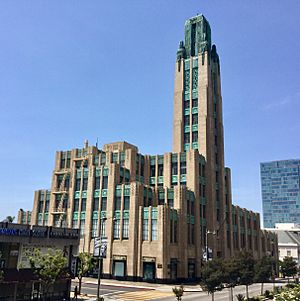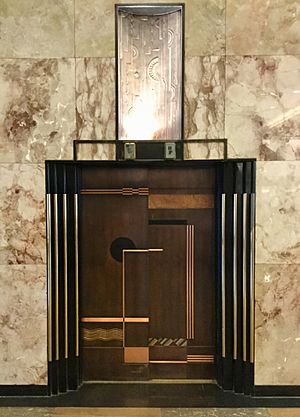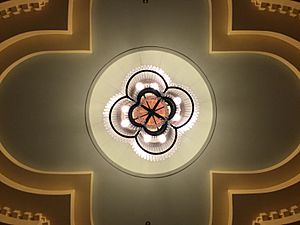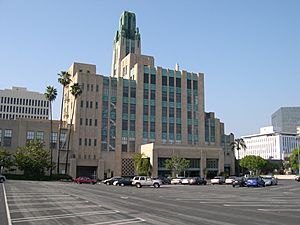Bullocks Wilshire facts for kids
|
Bullocks Wilshire
|
|
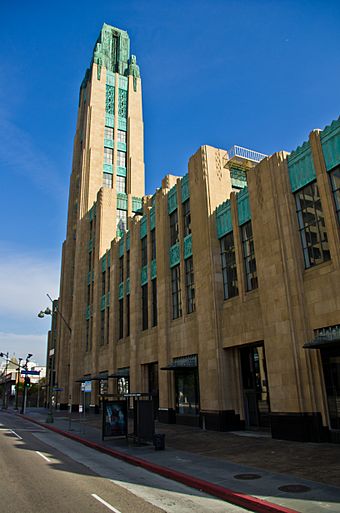
Bullocks Wilshire looking east
|
|
| Location | 3050 Wilshire Blvd Los Angeles, California, United States |
|---|---|
| Built | 1929 |
| Architect | John and Donald Parkinson |
| Architectural style | Art Deco |
| NRHP reference No. | 78000685 |
Quick facts for kids Significant dates |
|
| Added to NRHP | May 25, 1978 |
Bullocks Wilshire is a famous Art Deco building located at 3050 Wilshire Boulevard in Los Angeles, California. It opened in September 1929 as a fancy department store. John G. Bullock, who owned other stores, created it. This Los Angeles store was the main one for the Bullocks Wilshire chain. Today, Southwestern Law School owns this historic building.
Contents
History of Bullocks Wilshire
The Bullocks Wilshire building has a rich history. It was designed to be a special place for shoppers.
Building Design and Style
The building was designed by famous Los Angeles architects John and Donald Parkinson. The inside was planned by Eleanor Lemaire and Jock Peters. A beautiful ceiling mural in the entrance was painted by Herman Sachs.
Outside Features
The outside of the building is known for its tall tower. This tower is 241 feet high. Its top is covered in copper, which has turned green over time. Long ago, a light on the tower could be seen from far away.
Bullocks Wilshire was special because it was one of the first department stores in Los Angeles made for people who drove cars. It was built in a quiet neighborhood, away from downtown. This made it easier for shoppers to visit.
The store had traditional display windows facing the street. These were decorated to catch the eye of people driving by. Since most customers arrived by car, the main entrance was at the back. There was a special covered area called a porte-cochère. Here, valets would greet customers and park their cars.
Inside the Store
When shoppers entered, they found a grand foyer with travertine floors. The elevators were decorated with shiny nickel, brass, and gunmetal.
On the first floor was the Perfume Hall. It had a high, arched ceiling and natural light. The walls were made of beautiful St. Genevieve marble. Other floors showed clothes and accessories in low glass cases. They were placed on rosewood stands or shown on live mannequins. This kept the store looking open and uncluttered.
Upstairs, there were special showrooms and salons. These felt like small, fancy shops. The Louis XVI Room sold designer dresses. The Directoire room offered formal wear and later, furs. Later, the Chanel Room opened for high-fashion clothes. The Irene Salon was also famous. It was started by Irene Lentz, who became a Hollywood costume designer. This was one of the first shops inside a big U.S. department store dedicated to one designer.
Other parts of the store included a toy section. There was even a "Doggery" on a mezzanine for dog accessories! The store also had the city's first leisurewear section called the Playdeck. The women's shoe salon had walls made from wood from a single Central American tree. The fur workshop had walls lined with colorful cork. The Saddle Shop had red floor tiles and a life-size plaster horse named Bullock's Barney.
For snacks, there was a desert-themed tearoom on the top floor. Next to it was a lounge where women would meet for lunch and fashion shows. Very important men could shop in private. J.G. Bullock had a wood-paneled suite on the fifth floor. Business leaders and politicians could relax there. Sales associates would show them gifts while they enjoyed drinks and snacks.
Famous Visitors and Staff
The department store was a favorite for many famous people in Los Angeles. During its busiest years, stars like Mae West, John Wayne, Marlene Dietrich, Joan Crawford, Alfred Hitchcock, Greta Garbo, Walt Disney, and Clark Gable shopped there.
Even some future stars worked there! A young Angela Lansbury worked as a sales clerk. Patricia Nixon, who later became a First Lady, also worked at the store. Neil Gittings photographed many celebrities from his studio next to the Chanel department.
Later Years and Closure
In the 1970s, Bullocks Wilshire started opening more stores. These were in places like Palm Springs (1947), Woodland Hills (1973), and Newport Beach (1977). These new stores helped keep its luxury image separate from the main Bullock's chain.
Over the years, many luxury stores moved to the west side of Los Angeles. This made the area around the main Bullocks Wilshire store less popular. The store started to decline in 1988. Its final owners, Macy's, bought the chain.
The Wilshire Boulevard store was badly damaged during the Los Angeles riots of 1992. People broke in and smashed display cases on the first floor. Luckily, the upper floors were saved because staff turned off the elevators. The store was built without escalators, which may have helped prevent more damage. A few small fires were set, but they did not spread.
Bullocks Wilshire finally closed in 1993. There were legal issues as Macy's tried to remove historic items from the store. But after pressure, almost all the original 1929 fixtures were returned. The Bullocks Wilshire stores were changed to I. Magnin stores around 1990. However, I. Magnin itself closed in 1995.
What the Building Is Used For Now
In 1994, Southwestern Law School bought the building. The school is a long-time neighbor of the store. They carefully restored the building to how it looked in 1929. Now, it is an important part of the law school.
The building is a historic landmark for the City of Los Angeles. It was added to the National Register of Historic Places on May 25, 1978.
The building is also used for filming movies and TV shows. Here are some scenes filmed there:
- A scene in the 2004 movie The Aviator
- Featured in the 1996 movie Dunston Checks In
- Mall scenes from the 1984 movie Night of the Comet
- A scene in the TV show Moonlighting
- Featured in the 1937 movie Topper starring Cary Grant
- In Aerosmith's 1989 "Love in an Elevator" music video
- Public Enemy's music video for "By the Time I Get to Arizona"
- Part of the background on the set of The Tonight Show with Conan O'Brien
Bullocks Wilshire Store Locations
The Bullocks Wilshire chain grew from the main store in Los Angeles. Here are some of its locations:
- Wilshire (main store), opened September 24, 1929 – now Southwestern Law School
- Palm Springs (freestanding), opened October 18, 1947
- Woodland Hills Promenade, opened August 20, 1973
- Newport Beach (Fashion Island), opened August 1, 1977 – now the site of Nordstrom
- La Jolla Village Square, San Diego, opened August 20, 1979
- Palos Verdes (Rolling Hills Estates), opened September 28, 1981 – now individual retail stores and a cinema
- Palm Desert Town Center, opened February 7, 1987
Images for kids


